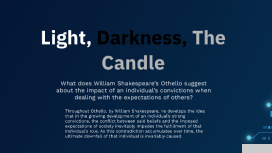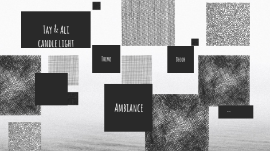Light, Darkness, The Candle
Transcript: Light, Darkness, The Candle What does William Shakespeare’s Othello suggest about the impact of an individual’s convictions when dealing with the expectations of others? Throughout Othello, by William Shakespeare, he develops the idea that in the growing development of an individual’s strong convictions, the conflict between said beliefs and the imposed expectations of society inevitably impedes the fulfillment of that individual’s role. As this contradiction accumulates over time, the ultimate downfall of that individual is invariably caused. Darkness The Light “Destruction on my head if my bad blame light on the man.” (Act I, Scene 2, Line 204-205) - Brabantio Light appears numerous times throughout the play, with it being symbolic of truth in most cases. In the context of the scene that this quote takes place in, “light” symbolizes purity and truth. The truth, which Brabantio tries fiercely to have Othello confess. However, if Desdemona is able to testify the honesty of Othello, then Brabantio’s mistake would have “blamed” his light. This quote serves as one of the first that establishes the symbolic connection between light and truth. Despite Brabantio's certainty in his beliefs in this scene, he is eventually proved false by Desdemona in the end. This sets an early example of one’s potential to be inaccurate in their convictions, which in turn would cause them to stray off the path of achieving something that is expected of them by others. This idea holds direct ties with the central plot of Othello, where complete and utter tragedy can result from one’s own false convictions. “Wake him up. We’ll slander Othello in the streets, and ruin his happiness by getting his wife’s family all riled up.” (Act I, Scene 1, Lines 71-73) - Iago Throughout the play, darkness is usually not explicitly mentioned but rather implied through the context of the scene. In most cases, the context that the absence of light is utilized for is one that is filled with deception, lies, and crime. The first scene of the play exemplifies this, using the atmosphere of darkness as the setting for the first instance of Iago’s deceit. Employing the common association of darkness with not only impurity, but also the obstruction of the truth, an appropriate setting is established for this scene. Further instances of light and darkness, being associated with clarity and obscurity will arise throughout the rest of the play. “Will you, I pray, demand that demi-devil why he hath thus ensnared my soul and body?” (Act V, Scene 2, Lines 353-354) - Othello Following the established connection between darkness and Hell, referring to Iago as a “demi-devil” not only embeds the association of Hell into his character, but by proxy - the association of darkness as well. This idea is also exemplified by the quote, “When devils will the blackest sins on, they do suggest at first with heavenly shows as I do now”. (Act II, Scene 3, Lines 371-373) - Iago As Iago directly compares himself to a devil with the blackest of sins, the imagery of black not only shares similar connotations with darkness, but once again reinforces the connection that darkness has with this character. (Act 1, Scene 2, Lines 446-447) - Iago “I have’t. It is engendered. Hell and night must bring this monstrous birth to the world’s light.” At the end of Act 1, a soliloquy from Iago explicitly highlights the symbolism between darkness, light, and their relation to each other. As his plan is successfully formulated, expressed by the quote, “I have’t. It is engendered”, he directly associates Hell with the darkness of night. Referring to his strategy as a “monstrous birth” perfectly encapsulates the sinister nature of this plan, and indicates the malicious intentions of Iago to the viewers. Here, connections between darkness with impurity/deceit, and light with truth/purity are purposefully established for the rest of the play. The concept of tainting the world’s light with the darkness of Iago’s deceitful plan, parallels the relationship between truth and falsity and how deception can triumph over the other in acts of concealment. This symbolism is reinforced through several other instances of this comparison, and strengthens the central idea suggested by Othello. That one’s firm beliefs and convictions can be potentially composed of fabrications and fraudulency, which can lead individuals to their eventual demise as such made perspectives are often destructive or harmful by nature. As the story follows the downfall of Othello, this thematic idea is reflected by his story arc as he is led astray by deception until the cumulation of his suspicions results in his ultimate tragedy. (Act 3, Scene 3, Lines 526-530) “Witness, you ever-burning lights above, you elements that clip us round about, witness that here Iago doth give up the execution of his wit, hands, heart to wronged Othello’s service!” - Iago In this moment of the play, Iago’s reference towards a “light” from above is once again

















